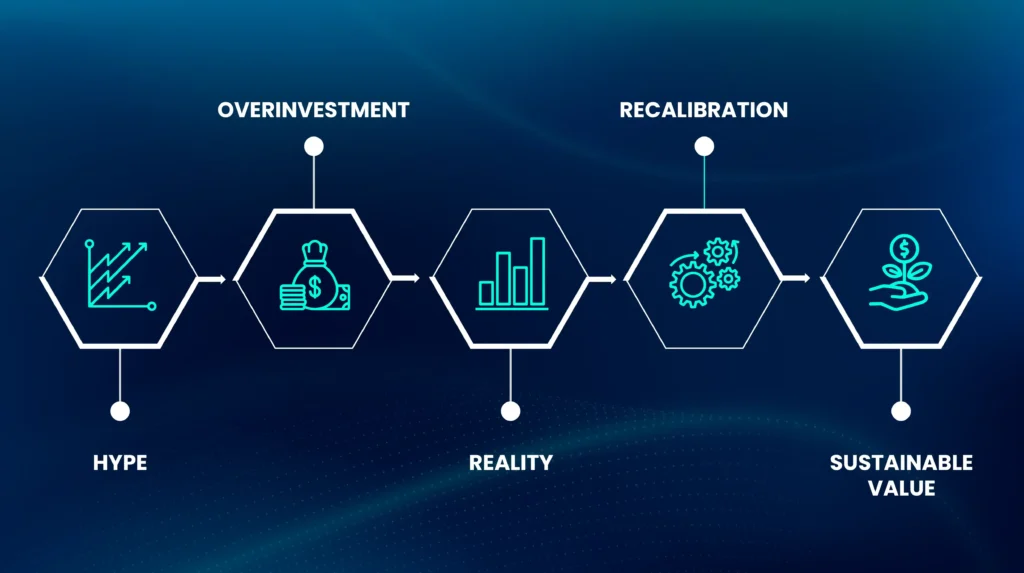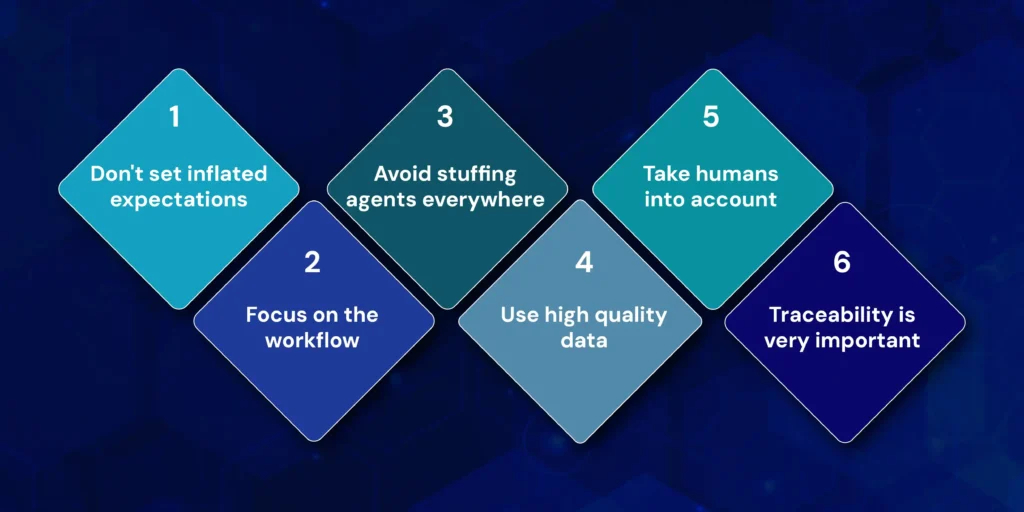
Gartner published a very alarming report recently that paints a gloomy picture of the agentic AI revolution. According to the firm, over 40% of agentic AI projects will be canceled by 2027.
The road to success is always bumpy for any new technology. But over 40% is a staggering number, which shows that something is seriously wrong. We at Xavor agree that agentic AI is as complex as it is a promising technology. But in our experience, the problem is not with agentic AI; rather, it is the flawed implementation strategy that businesses adopt.
In this article, we’ll explore why agentic AI initiatives face setbacks, and what you can do to do things differently.
Why is agentic AI adoption failing?
Nowadays, you can build AI agents yourself from scratch. Just go on YouTube, watch some tutorials, and you can make an amazing AI agent. It will work perfectly on your computer, might impress your boss in demos, and it’s good to go, right?
Not exactly, since deploying AI agents in real-life business workflows is an entirely different ball game. And this is where enterprises are getting agentic AI wrong. It isn’t some plug-and-play technology that will automatically adapt to your business.
You need to fine-tune the technology according to your own workflows. Only then will it give you the results that you want.
Agent washing
Some vendors are also doing something called “agent washing”. It is rebranding existing products like AI assistants, conversational chatbots, and automation robots as AI agents without any real agentic AI capabilities.
Agentic AI has a very specific meaning, and it is deeply tied to autonomy. Marketing any automation tool as agentic is like selling counterfeited goods in fancy packaging. Out of the thousands of agentic AI companies right now, only a fraction are offering genuine agentic AI tools.
These factors are adding to the agentic AI hype without actual outputs. And as a result, when businesses don’t meet their expectations, it makes them disillusioned with the technology.
Why failure isn’t a bad thing

The Hype Cycle is a model that explains how new technologies typically evolve from excitement to maturity
However, these early setbacks are in no way the end of it. The technology is still largely in its experimental phase, and many major technologies have gone through this reality check. The infamous dot-com crash of the early 2000s helped purge weak fundamentals and business models during the internet boom.
The survivors then built reliable infrastructure, which separated the hype from real value. Similarly, these failures will prompt businesses to recalibrate their agentic AI methods and deliver sustainable value.
Xavor’s approach for building agentic AI that delivers
“Fools learn from experience. I prefer to learn from the experience of others.”, said Otto von Bismarck. You can position your business forward by vicariously learning from others’ experiences working with agentic AI. That way, when the technology fully matures, you’ll be ahead of the curve.
We’ve led several agentic AI cases at Xavor, which has given us the nous to implement the technology successfully. Based on that experience, we’ve gathered these six core principles for successful agentic AI implementation. These principles or best practices will help you derive value from your agentic AI investment.

1. Don’t set inflated expectations
AI agents are very powerful, smart tools that can solve some of the most complex problems without any human intervention. But they aren’t some panaceas to all your business challenges.
As mentioned earlier, agentic AI is still in its early phases, and it takes several development iterations to deliver the intended results. But business heads and executives expect instant results, almost like magic.
Not understanding what agentic AI is, its limitations, and where it should be used leads to project failures from the onset. Therefore, set realistic expectations from the start to avoid disappointment later.
Get expert help if you don’t know agentic AI that well. Agentic AI consulting companies can help you devise a strategic roadmap that is based on real-world situations.
2. Focus on the workflow; not on the agent
Einstein said that insanity is doing the same thing over and over and expecting different results. Too many businesses are unfortunately doing that with agentic AI. They keep building isolated agents that look great on paper, but don’t align with their workflows.
Overcoming this predicament requires redesigning your workflows. And workflow realignment isn’t just about inserting agents; you need to involve all the people, processes, and technologies to see how agentic AI can help with each of these steps.
This will also give you the right view about where automation is most useful, and where human expertise is more valued.
3. Avoid stuffing agents everywhere
Just because you can doesn’t mean you should. If an AI agent can do something, it doesn’t mean it necessarily has to be used. Businesses are using agents everywhere without considering whether an agent is the best choice for that particular task.
Sometimes, predictive models or simple rules-based systems do the job better than an AI agent. It helps avoid wastage of resources and makes your work less complex. Therefore, we recommend treating agentic AI as a tiered option in your toolbox. Some agents can do certain tasks well, and in other cases, it is better to use other technologies.
But how can you figure that out? Agents do their best when things are unpredictable or need judgment. Like in financial risk assessment or IT resolutions, where there is no fixed pattern, and the agents can make judgements based on anomalies, context, and weigh trade-offs.
4. Use high quality data
AI agents are only as good as the data they use. If the information they rely on is messy, incomplete, outdated, or inconsistent, their decisions will also be flawed. However, giving AI agents the right data isn’t so straightforward.
Because agents are autonomous, they can even access irrelevant or sensitive data that you never intended to give them. This is part of a concerning security problem with AI systems, known as the lethal trifecta, which even giants like Microsoft have found in their Copilot.
Therefore, you need to clean your data pipelines and put guardrails around agents to ensure that they only access the right data needed for their tasks. Whether it’s structured or unstructured data, it needs to be clean, consistent, and controlled for an AI agent to make correct, reliable decisions.
5. Take humans into account
It takes a lot of human intelligence to make artificial intelligence work. Your employees who are actually going to use those agents are essential to the success of your agentic AI project.
Yes, we know there are polarizing views around AI and the modern workforce. They go to the very top with divergence between even industry giants. Palantir’s CEO, Alex Karp, recently criticized Silicon Valley for doing a “crappy job” in dispelling the fear that AI is taking away job security. He is of the view that AI will only augment workers and make their work more valuable.
We consider this as the balanced take. AI will definitely change the type and quantity of work humans will do. But they will remain integral to oversee the agents, monitor them, and improve their performance based on feedback.
Even if the agent, workflow, and everything are perfectly set in place, cultural adoption can derail success. Users resist agents if they feel threatened or if incentives aren’t enough. That is why you must pay attention to change management to prepare the people in your organization for the new technology.
6. Traceability is as important as outcome
Make sure that whenever an AI agent extracts information, it also records where the information came from. This auditability lets you know the reasoning path of the agent and monitors the origin of every fact.
However, this is relatively easy when you’re using just a few agents. But once companies start using dozens of agents, it gets much harder. If something goes wrong, they can’t trace why it happened, or which agent was responsible. That is why it is essential to ensure a traceability-first design in your agentic AI setup.
If you track how the agent makes each decision, you can spot problems earlier, fix them faster, and keep improving performance over time.
Final takeaway
Ambition isn’t alone enough to guarantee success. If that were the case, every climber would’ve reached the summit of Mount Everest, but it took 30 years of failed attempts until the peak was summited by Edmund Hillary.
However, you don’t have to wait for that long to realize your agentic AI ambitions. If your project falls into that 40% category, it will be remembered only as another failed experiment in the rush to reach the top of the AI race. But if your approach is sound, backed by real-world lessons, you can be one of the early successful adopters of enterprise-level AI solutions.
It is in your hands if your agentic AI project will be one of the few that actually achieve success. That’s exactly what we help businesses with at Xavor. Our AI consulting services develop and implement agentic AI solutions that improve the performance and reliability of business systems.
Drop us a line at [email protected] and our AI experts will get back to you within 24–48 hours.
